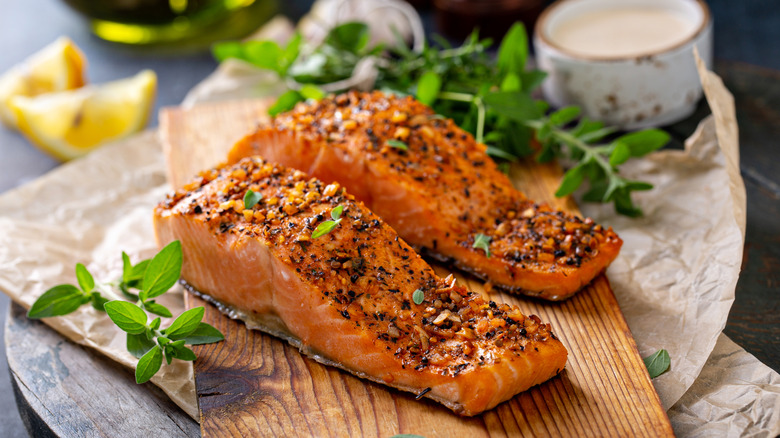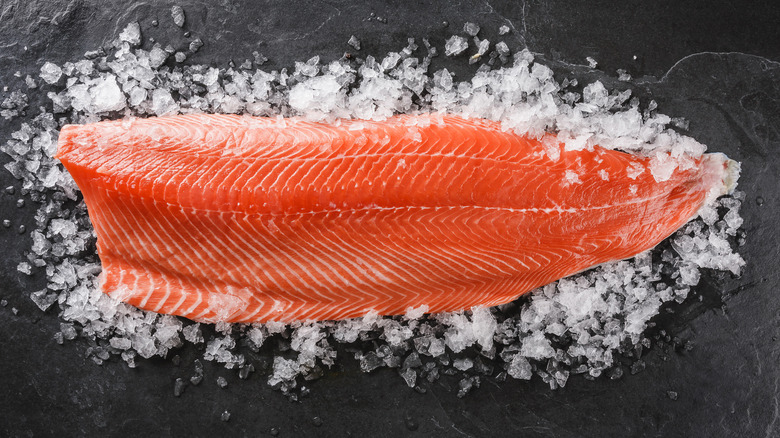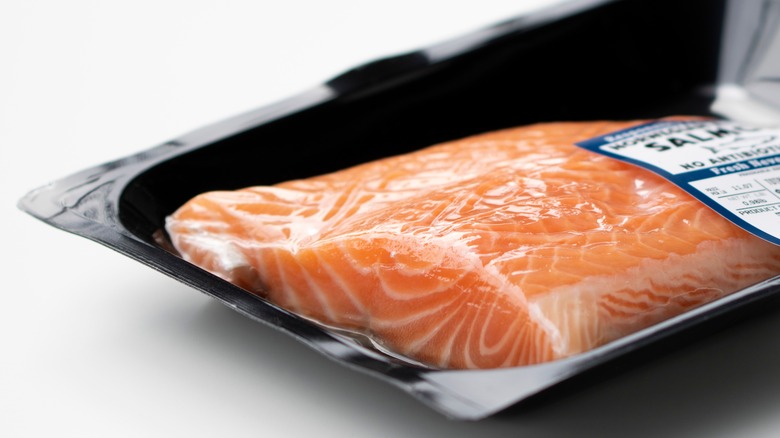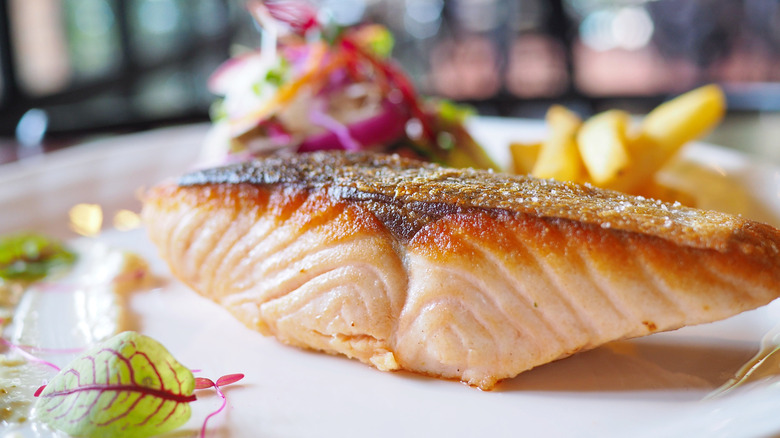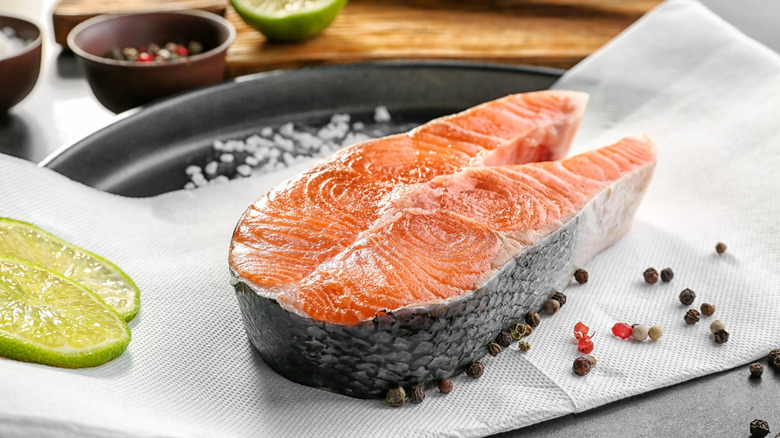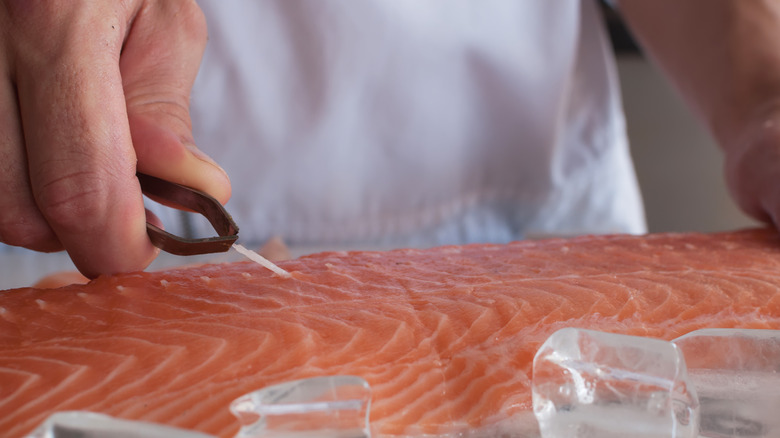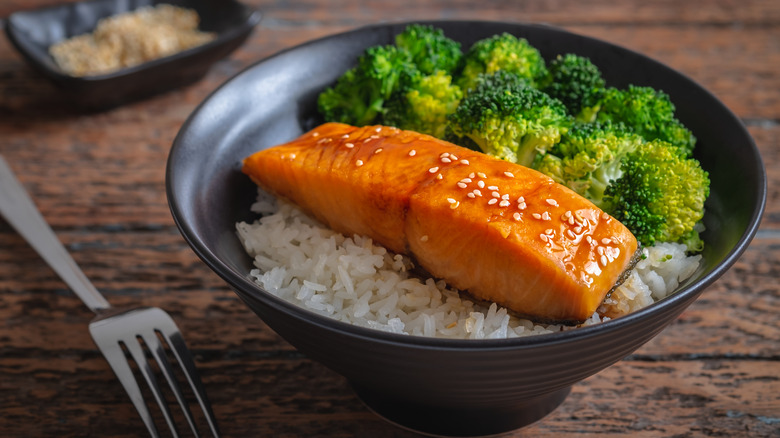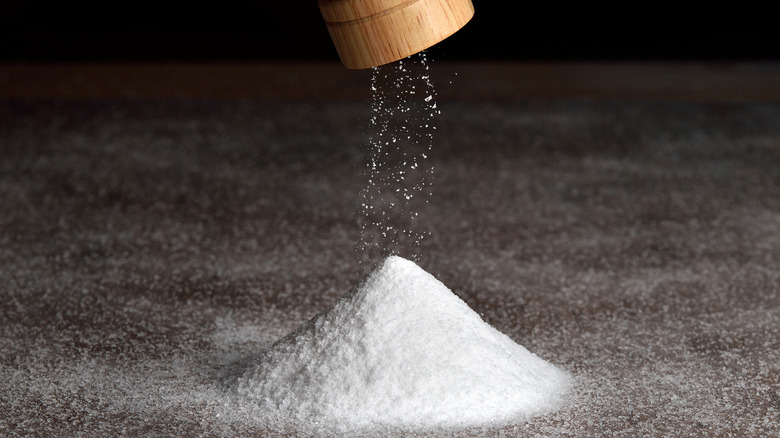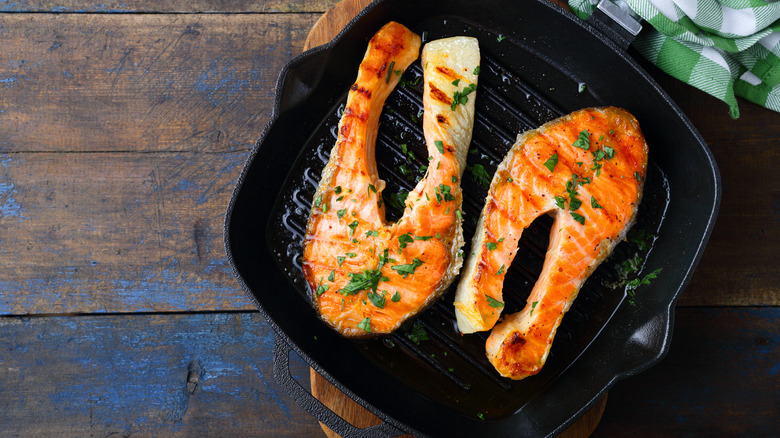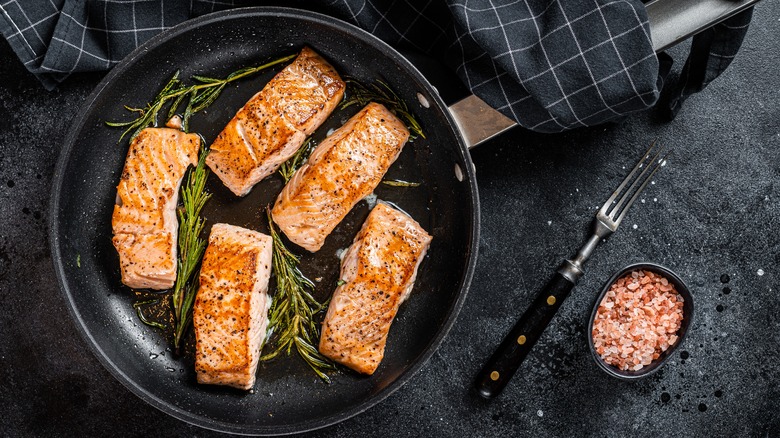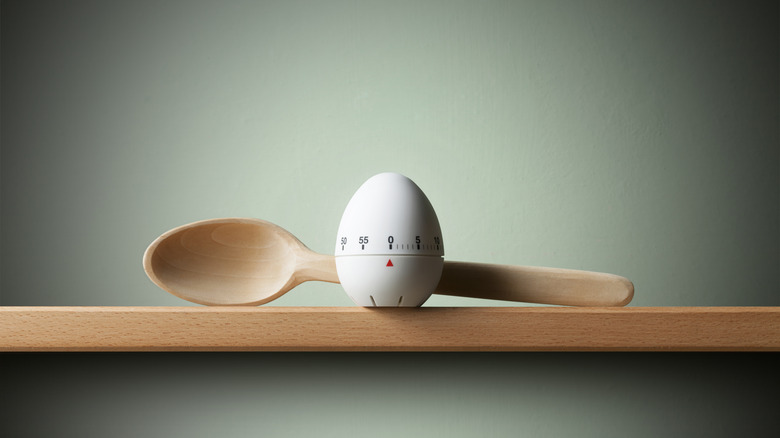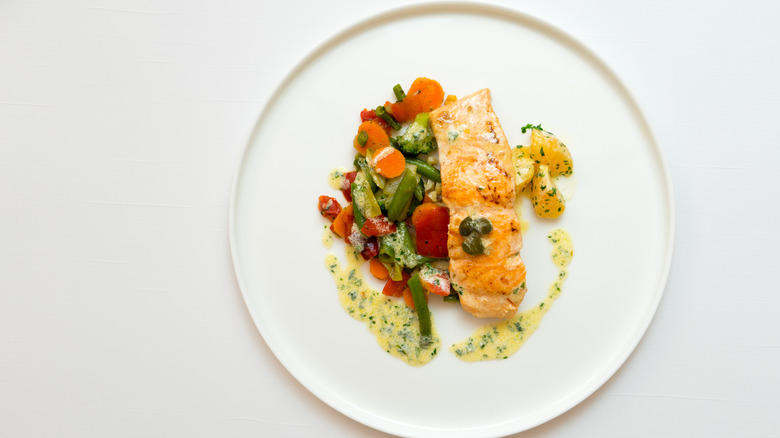11 Mistakes Everyone Makes When Cooking Salmon
When you're having someone over for dinner and want to make a meal to impress them, salmon is an elegant choice. It may seem like a simple dish to prepare, however, there are several things you'll want to keep in mind to avoid the common mistakes everyone makes when cooking salmon.
It all begins with choosing the right cut of fish to suit your needs, and knowing how to identify fresh fish in the grocery store or fish market. Storing the fish correctly, knowing when and how to cook it, ensuring you have the right equipment, and understanding the different flavor combinations that can elevate your salmon cooking, all go a long way to helping you feel confident the next time you or your guests fancy fish. We've got you covered with the mistakes that are easy to make — and just as easy to correct — when it comes to cooking salmon.
1. Not buying the freshest and best cut to suit you
If you grab a fillet of salmon in haste and don't spend a bit of time choosing the best piece of fish, it will jeopardize your dish. You want to buy and consume the freshest salmon because the taste and texture will be beautiful, it's healthier for you, and if it's off, you could get sick – something you'll definitely want to avoid.
To find the freshest salmon look at the color. Farmed salmon usually has a light pink hue, while wild salmon tends to be a darker shade of pink. Press the flesh gently; it should feel firm and bounce back when touched. Fresh salmon won't have a strong odor, if it does, bin it. Other signs of spoiled salmon are a slimy texture or a gray or brownish hue. Always make sure you're buying a cut you can handle to reduce wastage. If you're hosting dinner guests, don't attempt to cook a whole salmon for the first time. Stick to the more manageable pre-cut salmon fillets from the supermarket, which usually have a shelf life of about six days. If you're comfortable working with a whole fillet, which is a side of salmon, British chef Jamie Oliver's website says the fish meat should "shine."
2. Not cooking your salmon the same day
Fresh fish is the best fish, as the saying goes. We can't be that organized all the time, but the sooner you cook your store or fishmonger-bought salmon, the better. Did you know that salmon can only remain fresh for up to two hours at room temperature before it begins to break down? Keep your salmon refrigerated to enjoy it at its best. There's no need to bring your fish up to room temperature before cooking, it can go straight from the fridge to the frying pan. Also, not only does refrigerating your salmon keep it fresh, but it also helps the fish retain its moisture.
That said, don't leave your salmon in the fridge for days before cooking it. Fresh fish is continually breaking down. According to salmon experts BluGlacier, if your salmon sits in the fridge too long its valuable protein and amino-3 fatty acids start to spoil. And let's be honest, most of us eat fish for its protein and amino-3 fatty acids so don't let it go to waste, cook your salmon sooner rather than later to reap all the benefits.
3. Taking the skin off
There are two factions when it comes to salmon skin, those who like it on and those who like it off. The choice is yours. If you like skinless salmon, don't make the mistake of removing the skin before you cook your salmon. The reason chefs leave the skin on when cooking salmon is because the skin serves as a protective barrier and keeps the fish moist. The winning technique for cooking salmon fillets is to cook it skin down. This crisps up the salmon skin and prevents the soft flakes of fish from sticking to the pan.
If you don't want to eat your salmon with the skin on, you could remove it in two ways. It's much easier to remove salmon skin once it has been cooked. If it's a fillet, crispy salmon skin can be neatly peeled off once cooked. If you absolutely must remove the skin of your salmon before cooking it, try out this technique of pouring boiling water over salmon fillets to lift the skin.
4. Rinsing your salmon
Why do we want to rinse fish or meat? Is it because we habitually rinse our fruit and veg to rid them of wax and pesticides? Is it to rinse it of its odor or to somehow make it "more clean" after all the hands it has been through to get to you? Or is it because that's what our parents and grandparents did? The truth is, that rinsing salmon, chicken, or pork doesn't get rid of bacteria; in fact, it spreads bacteria.
According to the USDA, washing raw salmon or rinsing meat and poultry in water can spread bacteria throughout the kitchen, contaminating countertops, nearby food, and even yourself. Water splashes can carry bacteria up to three feet around your sink, increasing the risk of illness through cross-contamination. Researchers at Drexel University advise that transferring meat and poultry directly from its packaging into a roasting dish or pan is safest. The heat from cooking will effectively kill any bacteria present, ensuring food safety.
5. Not checking for bones
When you buy salmon from the supermarket or a fishmonger, it has usually been deboned. However, some thin bones might be lurking and it's good to always check your fillet or side of salmon for bones by gently running your clean fingers over it. Finding a bone in your fish at the dinner table is a bit of a faux pas, almost as bad as a guest finding hair in their food. The difference is, you can choke on a bone and it can damage your throat.
To check for bones in your salmon, glide your finger along the meat of the fish, against the grain. If it's a side or whole salmon, start by running your fingers along the spine area and work your way outwards. What you're looking for is any protrusions or bumps on the smooth skin. Use tweezers, narrow pliers, or your fingers to remove the bones. It's best to test for bones before you season and cook your fish and when you do it, do your best not to damage the fish by making big gouges. Take your time and make your incisions as unnoticeable as possible.
6. Using the wrong flavor combination or no seasoning at all
Salmon is a unique-tasting fish, both in flavor and texture. Certain flavors belong with salmon, like dill, soy, or ginger, and some just don't — like cilantro. Think carefully before pairing your salmon with any herbs that happen to be in the fridge. "Honey, soy sauce, and garlic make for a delicious combination ... with the sweet, salty, and savory flavors all balancing each other perfectly," says recipe developer Catherine Brookes. For an Asian twist, try out her honey-garlic pan-seared salmon recipe.
If you forget to season your salmon before cooking it, it will come out dry and with a bland taste. When you season your salmon with salt and pepper before cooking it, this locks in moisture and heightens its flavor. For a baked salmon dish where you cook the fish in a parcel of parchment paper that contains parsley, garlic, and lemon juice try this Salmon En Papillote With Persillade.
7. Over seasoning/salting salmon, which is very easy to do
Once you've added too much salt, it can't be undone. There's a tendency to want to oversalt salmon because it has a subtle flavor. It just needs a generous sprinkle of salt, not a crust of seasoning. The way to manage how much salt you add is to use your hand. Instead of pouring or grinding salt onto the fish, from a salt shaker or grinder, rather put the desired amount of salt into the palm of your hand and add it pinch by pinch, seasoning your salmon until you're satisfied you've added enough salt. What is enough? Take a look at how Jamie Oliver seasons his fillet of salmon to get an idea.
You can always add a bit more salt later. That said, don't underseason or not season at all. We recommend using semi-coarse sea salt. And don't forget a grind or two of pepper to add depth and a touch of spice to your salmon.
8. Using the wrong pan
You go to all the effort of buying and preparing your salmon and in your haste, you grab the wrong pan. This results in the skin sticking to the pan and your fish disintegrating as you try to turn it. The best pan to cook salmon in is a non-stick or griddle pan. Don't waste your time or olive oil on anything else. A griddle pan is a non-stick pan that has raised edges or grooves. The ridges on the surface create grill marks and excess fat can drip away. It's a healthier cooking method than normal frying pans. A non-stick frying pan has a coating on it, like Teflon, which prevents food from sticking to the pan while cooking.
Another salmon cooking tip that's going to earn you points in the kitchen is placing your salmon fillet in a non-stick or griddle pan while the pan is still heating up. Don't wait until it's piping hot to put your salmon in. The reason for this is the fish will cook more evenly if you start it in a pan that is cold and still warming up.
9. Cooking it skin-side up and using oil
If you don't cook fish all the time it's easy to forget the rule about cooking fish skin-side down. When you cook a fillet of salmon skin-side up, the fish will stick to the pan, fall apart, and lose its moisture. Cook a salmon skin-side down and the skin cooks first, becoming crispy and not sticking to the base of the pan (if you're using a non-stick or grill pan). The skin will keep the integrity of the shape of your fish and prevent it from disintegrating. It also locks in moisture.
In this one-minute video, celebrity chef Jamie Oliver shows viewers how to perfectly grill salmon. Notice how he places his salmon skin down. A great trick he also swears by is not using olive oil, instead, he puts the fillet straight into the non-stick pan. Salmon is a fatty fish and releases oils while cooking, maximizing its unique flavor. Because of this, it doesn't necessarily need oil to cook.
10. Overcooking your salmon
Timing is everything when cooking fish, especially an expensive one like salmon. A common mistake made when frying, baking, or poaching salmon, is overcooking it. When you overcook salmon, it becomes dry and tough. To perfectly pan-fry salmon "cook the salmon for two to three minutes, skin-side down until the color of the fish becomes opaque from the bottom to the top," recommends seafood chef Bart van Olphen. "Turn the salmon over and let it cook for another minute." If your fillet is particularly big or small, van Olphen suggests using common sense to adjust the timing more or less.
For poaching, van Olphen puts salmon on the stove with cold stock and lets it cook for eight to 10 minutes before it reaches a boiling point. British TV chef, Rick Stein, who is also a seafood specialist believes salmon is best cooked without direct heat like poaching. "For me, this could mean popping it into a curry just as the sauce is about finished, lid on, and simmer gently for five minutes," he told The Daily Mail. "Salmon cooking gently yields such a lovely delicate flavor that can be lost in high heat applications." The timing rule to follow for better oven-baked salmon is eight minutes for every inch of thickness or four minutes for every half-inch for thinner filets. The lesson is, when cooking salmon use your head and always use a timer!
11. Putting in all the effort and not plating your salmon like a chef
Preparing a beautiful meal takes time. You think about what you want to cook, source a recipe (or construct it in your mind), get together a list of all the ingredients you want, head to the farmer's market or supermarket ... you catch the drift. Why go to all this trouble and then drop the ball at the end?
You may be salivating as you're dishing up your meal and be tempted to overload your plate. Hold back. The first bite is with the eyes, as the saying goes. Rather impress your guests and your stomach, by getting strategic about how you plate. First, don't hide the salmon under a bed of greens or mashed potatoes. Serve it on top of the greens, if it's a fillet, or alongside the mash. There's no denying, that the pink hue of cooked salmon, compliments the flush of freshly blanched asparagus, pak choi, or string beans. When interviewed by CNN, TV chef Ina Garten recommended using white plates, so the food "pops", remaining the center of attention. "I never like plates that have patterns on them," she says.

